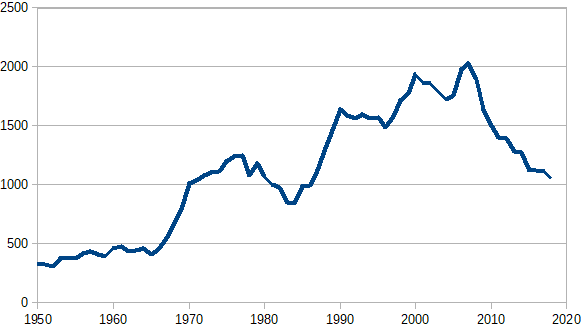Yes, that’s from Life of Brian.
One interesting trend of baby names is the diversification. Parents are frequently choosing names that are non-traditional/non-standard. Even the most popular names are chosen less frequently than before. To see this change, let’s compare 1959, which is very close to the peak of the baby boom, with 2018.
The most popular names are not as popular. In 1959, Michael topped the boy’s list. 3.9% of the boys born in 1959 were named Michael. In 2018, Liam was the number one boys name, but only 1.0% of boys got that name. On the girls side, numbers were: 1959: Mary (2.6%); 2018: Emma (1.0%).
Another way to look at it: The percentage of babies accounted for by the top 10 names:
| 1959 | 2018 | |
| Boys | 28.9% | 7.4% |
| Girls | 17.5% | 7.5% |
Another metric: going down the list of most popular names, how many does it take until 50% of the babies are included.
| 1959 | 2018 | |
| Boys | Top 31 | Top 179 |
| Girls | Top 61 | Top 333 |
Total number of names. Not only are the popular names less popular, but parents are creating new names all the time. Here are the raw numbers – the total number of baby names used in a given year. (Remember, the data does not include names that have less than five occurrences, for privacy/anonymization reasons. So these counts are of all the baby names that were used at least five times in a given year. Even more obscure names don’t show up in the data.)
| 1959 | 2018 | |
| Boys | 4,571 | 14,004 |
| Girls | 7,196 | 18,029 |
Here’s a graph of the number of new baby names created in each year.

So we peaked with the “let’s invent a name for our baby” fad in 2007. But the other diversification trends, discussed at the top of this post, are continuing to this day. I guess we really are all different. Except for that one guy.
